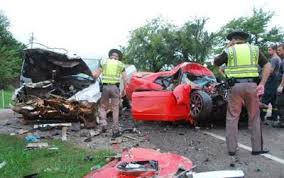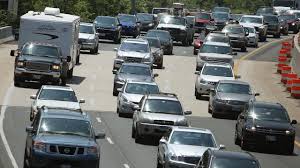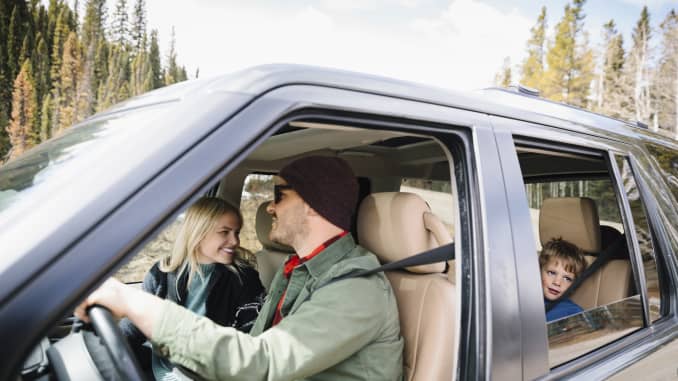
(UNDATED) – Today’s average gas price of just over $2.58 per gallon is 25 cents cheaper than during the Labor Day weekend last year, according to AAA.

If you’re heading out on an end-of-summer road trip this Labor Day, you might find yourself spending less on fuel and more on food and fun.
That’s thanks to what may be the lowest average nationwide gasoline rates for this holiday weekend in three years, according to AAA.
Today’s average price of just more than $2.58 per gallon is 25 cents cheaper than during the Labor Day weekend last year, when it was $2.83, and 5 cents cheaper than the same period in 2017 ($2.63).
That means people will have more money in their pockets and they’ll be more likely to hit the road, said AAA spokesperson Jeanette Casselano. “When gas prices are cheaper, we tend to see more people traveling.”

“You’ve got your people who have their plans set in stone but you also have those who have been teetering, or it’s that last week of summer and they’ve been thinking about a road trip,” Casselano said. “People feel more inclined to take those road trips because they feel like they’re getting a better bang for their buck.”
But State and Local Police Departments are warning motorist Labor Day weekend can be a dangerous and deadly time to be on the road.
One of the most prevalent issues during holiday weekends is drunk driving.
The National Highway Traffic Safety Administration reported these drunk driving statistics from the Labor Day holiday weekend in 2017:
- 376 people died in car accidents.
- 256 of those who passed away were drivers.
- 37% percent of drivers who died in car crashes were under the influence of alcohol.
- 45% of drivers aged 21 to 34 who died in car crashes were drunk.
- 79% of fatalities involving drunk driving occurred at night.
The National Safety Council estimates that for 2019, there will be 398 fatalities over the Labor Day holiday weekend.

In Indiana
- Summer holidays are the deadliest for drivers—Fourth of July has the largest percent of monthly fatalities (15%) but Memorial Day and Labor Day are tied for second (13%)
- Holidays have more than 5 time more crash fatalities involving alcohol than non-holidays
- Nationwide, nearly 35% of alcohol-related holiday crash fatalities occur on Labor Day
- In Indiana, Labor Day is the deadliest holiday for drinking and driving
So what are the best practices to have a safe and fun Labor Day? Here are some tips to stay safe on the road this holiday:
Avoid peak driving days and times.
Many people are anxious to jump-start their holiday weekend by hitting the roads right after work, making late afternoon to early evening a busy and dangerous time to travel. It is recommended to leave as early as possible, between 5 a.m. and 7 a.m., Friday or Saturday morning. For coming home, it’s best to avoid “bumper to bumper” traffic by leaving before noon on Monday, before afternoon rush hour. If possible, travel on the Thursday before the holiday weekend or the Tuesday after.
Let a passenger handle the navigation apps.
Apps like Waze and Google Maps can help you not only keep you updated with real-time traffic, but they can also help plan your road trip with estimated arrival times. Letting one of your passengers use these apps as you drive—to keep you focused on the road, rather than on your phone—can help you find alternative routes should you encounter an accident or unexpected traffic. Of course, the broader issue of distracted driving is very serious and potentially deadly. So, as the driver, put your phone away!
Limit nighttime driving.
Because 79% of the 2017 Labor Day holiday fatalities occurred at night, consider avoiding being on roadways from sunset to sunrise. Night driving is more challenging than driving during the daytime, especially for older drivers. If you still want to go out at night, use safer alternatives such as ride-sharing, a taxi, or public transportation.
If you’re going to drink, do not drive. Period. And be aware of the potential effects of any medications you are taking. Even a blood alcohol concentration (BAC) of .02, which amounts to about one drink, can impact your vision and ability to multitask. If you’re going out with a group and you plan on drinking, designate a sober driver. Using ride-sharing or a taxi can be other ways to have fun without getting behind the wheel after drinking.
Always buckle up.
Whether you’re behind the wheel or a passenger, always wear your seat belt while riding in a vehicle. Seat belts can help save your life or reduce the severity of sustained injuries if you’re involved in a car crash. In 2017, seat belts helped to save close to 15,000 lives.
If you see a drunk driver on the road, call 911.
If you suspect someone is driving drunk (e.g., driving erratically, driving too fast or too slow), notify the authorities by calling 911. You’ll want to give them the name of the road or major intersection that the impaired driver is traveling on, as well as the direction in which they’re driving.
Another dangerous driving error is wrong-way driving – where a driver is driving in the wrong direction. This usually happens on highways, where a driver gets on an off-ramp. The NTSB reports that impaired driving is the number one cause of wrong-way driving. If you see wrong-way driving, drive on the most right-hand side of the road, stop at a safe place (e.g., a gas station), and then call 911.



